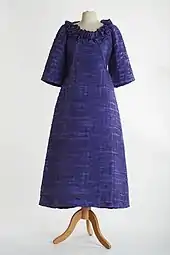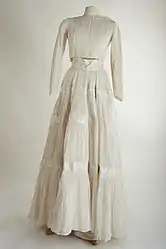Sybil Connolly
Sybil Connolly (24 January 1921 – 6 May 1998) was a Dublin-based fashion designer who was known for creating fashion from Irish textiles, including finely pleated linen, wools such as Báinín, Limerick and Carrickmacross lace, and later for her work with brands such as Tiffany & Co.. Her fashion label's famous clients included Jacqueline Kennedy.[2]
Sybil Connolly | |
|---|---|
 | |
| Born | 24 January 1921 |
| Died | 6 May 1998 (aged 77) |
| Occupation | Fashion designer |
Notable credit(s) | Honorary doctorate National University of Ireland, 1991[1] |
Said to have put Irish fashion on the map, she was a member of the "Big Three" Irish fashion designers (along with Irene Gilbert and Raymond Kenna/Kay Peterson),[3][4] and was described by former Taoiseach (prime minister) Jack Lynch as: "a national treasure".[5] Her activities were covered in both the fashion press and the social columns of publications such as the Hollywood Reporter.[6] Described by Bettina Ballard as a "personable milk-skinned Irish charmer",[7] she came to the notice of Carmel Snow, the Dalkey-born editor of Harpers Bazaar.
Early life and career
Sybil Connolly was born in Swansea.[2] Her father was an insurance salesman from Waterford, Ireland and her mother was of English and Welsh descent.[8] Her education came largely from her Welsh grandfather and private tutors.[8] Her father died while she was a teenager and the family moved to Ireland, where she spent two years at a convent school.[8] At seventeen her interest in clothes led her to be apprenticed to a London dressmaking company run by two Irish brothers, Jim and Comerford Bradley in London. Here she worked for their prestigious firm of Bradley & Co – whose clients included Queen Mary. Connolly would attend Buckingham Palace fittings where she was allowed to hold the pins.[8][5] Returning to Ireland in 1940, she worked for the Dublin store Richard Alan, remaining unknown to the general public, for the next thirteen years, until she replaced the French-Canadian head designer, Gaston Mallet in 1953. She was invited by Jack Clarke to produce the next season's range.[6] Here her work was spotted by American buyers.[8] She was known already for her textiles, including the crystal pleated linen that was said to take nine yards of material for each yard of finished cloth. It is said that she received her initial training at The Grafton Academy.[6]
Establishment of label

Connolly's first major fashion show was held at Dunsany Castle in 1953. Photographer Richard Dormer used the house and its grounds for a shoot of Connolly's clothes and one picture – showing model Anne Gunning in a full-length red Kinsale cape and white crochet evening dress – made the cover of Life magazine in August 1953 under the heading 'Irish invade fashion world'.[9]" It was a huge success – thanks in part to Harpers Bazaar editor Carmel Snow. It was attended by American press and buyers and her career took off rapidly after that, especially in the United States.[10][9] She wisely capitalised on this publicity by travelling, with her collection to the US later that year, where she made another life-long friend, Eleanor Lambert, doyenne of American fashion publicists. Avedon's photographs of Connolly and her fashions also ran in Harpers Bazaar of October 1953. Connolly officially launched her couture label in 1957; she was 36.[9]
Part of Connolly's success may be attributed to her flair for publicity.[10] She was also a glamorous advert for her brand – a 1954 feature in Housewife magazine gushed: "this fairytale person has looks. Short curling dark hair. Eyes the brown of peat...And a model figure too".[11] She was made part of the International Best Dressed List Hall of Fame in 1965.[12]
As her profile continued to rise in the United States, so did her client list – with Julie Andrews and Elizabeth Taylor wearing her clothes.[9] Notably, Jacqueline Kennedy wore a Sybil Connolly creation when she sat for an official Aaron Shikler White House portrait in 1970, wearing a Sybil Connolly pleated linen dress.[2] Many of her designs were sold, via private shows, to prominent social names such as Mellon, Rockefeller and Dupont family members.[8] By the time she was profiled in the Saturday Evening Post in November 1957, three-quarters of Sybil Connolly's gross earnings (then estimated at $500,000 per annum) originate in sales to the United States. She broadened her export market via a friendship with the newspaper magnate Frank Packer, with two heavily publicised visits to Australia in October 1954 and August 1957.[6]
In the late 1950s, she was employing around 100 women, half of them working from their own homes where they wove tweed or handmade lace.[6]
Among her assignments was to redesign habits for three orders of nuns – the Sisters of Mercy in the United States and two Irish orders.[8]
Brand hallmarks
Connolly was adept at reworking traditional Irish fabrics and styles – including peasant blouses, flannel petticoats and shawls – to give them contemporary appeal and glamour.[8][5] She took the red flannel traditionally used for petticoats in Connemara and turned it into huge billowing peasant skirts. Vawn Corrigan cites her importance in the re-imagination of Donegal tweed. [13] She made one skirt out of men's linen handkerchiefs, and in 1954 a summer dress out of striped linen tea towels, called the "Kitchen Fugue", leading her to be praised by Bazaar as someone with an "intuitively facile hand".[7] Perhaps her most distinctive contribution to fashion was pleated handkerchief linen – as worn by Jackie Kennedy in the official White House portrait – it took up to nine yards of Irish linen handkerchiefs to create one yard of the uncrushable pleated fabric that she pioneered.[9][5] Designs were created in Ireland, and Connolly employed up to 100 women, mostly crocheting and weaving in their own homes.[9] Although there was intricate craft in her designs, prices were lower than the typical European couture label.[9] The Hunt Museum contains examples of her work.[14] Connolly worked directly with the cloth, without preliminary sketches.[6]
Connolly also used other traditional Irish fabrics including Donegal tweed, and both Carrickmacross and Limerick lace.
The First Love dress
Sybil Connolly's signature design was the dress made from pleated handkerchief linen. The first pleated handkerchief linen garment to be shown in the United States was a white evening dress called First Love. It required three hundred handkerchiefs and contained more than five thousand pleats. Time magazine described it as "the dress that brought the house down" in the grand ballroom of the Waldorf Astoria, where it showed in March 1953 alongside Europe's top designers of the time, including Dior, Balenciaga and Visconti.[15] The First Love dress was made in the Clarke's Richard and Alan shop in 58 Grafton Street, Dublin, where Sybil Connolly worked for more than 10 years. In 1953 Connolly had only very recently begun designing dresses for the business.
In July 1954, Richard Clarke married Dorothy, and she wore the First Love Dress for the occasion. After the wedding, Dorothy had it shortened and wore it to dress dances. Almost 60 years later, when her granddaughter Anna Clarke got engaged, she asked her grandfather if she could wear it on her own big day. The dress was repaired and restored by freelance textile conservator Rachel Phelan in 2013, and Anna Clarke actually got to wear it.[16]
Later career
Her home, number 71 Merrion Square – which she described as "the house that linen built" – became a showcase for her taste and private clients would be served jasmine tea by a butler called James.[9][5] Located in one of the most fashionable areas of Dublin, it was what she called a "shop window for Ireland".[8] In the 1980s, Connolly began designing for luxury goods makers Tiffany & Co, Tipperary Crystal, Brunschwig & Fils and Schumacher.[8]
In her later career Connolly began designing interior fabrics and wallpapers. In the 1980s she became involved with the restoration of The Swiss cottage, Cahir, Co. Tipperary. The Cottage was originally built in the early 1800s by Richard Butler, 1st Earl of Glengall and based on a design by Regency architect John Nash. The cottage is rustic in style with a distinguished thatched roof. The interior theme was based on nature. Such was Connolly's interest in the restoration she helped to raise funds for the project. The Swiss Cottage opened to the public in 1989.[17][18]
In 2012, Connolly's work attracted renewed interest when actor Gillian Anderson wore a vintage dress by the designer for the BAFTAs.[19]
Gallery
References
- "NUI honorary degrees awarded" (PDF). nui.ie. National University of Ireland. Retrieved 16 August 2014.
- Tierney, Tom (1985). Great Fashion Designs of the Fifties. New York, NY: Dover Publications. p. 17. ISBN 978-0486249605.
- "Regard Dublin Stylists As Distinctly Different". The Central New Jersey Home News. New Brunswick, New Jersey. Associated Press. 21 April 1963. p. 15. Retrieved 30 January 2018 – via Newspapers.com.

- O Sullivan, Kathleen (16 November 2016). "'Fashion with an Irish Brogue': The Life And Legacy Of Sybil Connolly". headstuff.org. Archived from the original on 23 December 2017. Retrieved 30 January 2018.
- staff (14 May 1998). "Sybil Connolly". The Economist. Retrieved 16 August 2014.
- Robert., OB̀yrne (2000). After a fashion : a history of the Irish fashion industry. Raidió Teilifís Éireann., Aer Lingus. Dublin: Town House and Country House. ISBN 978-1860591150. OCLC 44422186.
- Penelope., Rowlands (2005). A dash of daring : Carmel Snow and her life in fashion, art, and letters (1st Atria Books hardcover ed.). New York: Atria Books. ISBN 9780743480451. OCLC 61448288.
- Nemy, Enid (8 May 1998). "Sybil Connolly, 77, Irish designer who dressed Jacqueline Kennedy". The New York Times. Retrieved 16 August 2014.
- Drohan, Freya. "Sybil Connolly: international fashion icon". womensmuseumofirelandie. Women's Museum of Ireland.
- Guinness, Desmond (28 May 1998). "Obituary: Sybil Connolly". The Independent. Retrieved 16 August 2014.
- Cheyne, Margaret. "Fashion with an Irish brogue". sheepandchick.blogspot.co.uk. Sheepandchick blogspot. Retrieved 16 August 2014.
- Vanity Fair
- Corrigan, Vawn (2020). Irish Tweed: History, Tradition, Fashion. O'Brien Press. ISBN 9781788490214.
- Elizabeth., McCrum (1996). Fabric & form : Irish fashion since 1950. Ulster Museum. Stroud, Gloucestershire: Sutton Pub. ISBN 978-0750912860. OCLC 36980360.
- O'Byrne, Robert. "A Woman of Substance". The Irish Aesthete. Retrieved 19 May 2018.
- Clarke, Anna (11 May 2013). "A classic from the attic". The Irish Times. Retrieved 19 May 2018.
- "Swiss Cottage". House Beautiful. 8 June 2009. Retrieved 18 May 2018.
- "Cottage Orné, Swiss Cottage, Cahir, County Tipperary". tipperary.com. Retrieved 18 May 2018.
- "Sybil Connolly – Ireland's first great fashion designer". glamourdaze.com. Glamour Daze. Retrieved 16 August 2014.
Bibliography
- Connolly, Sybil Irish Hands: The Tradition of Beautiful Crafts, Hearst Books, 1995.
External links
| Wikimedia Commons has media related to Sybil Connolly. |
- Sybil Connolly at FMD
- Hunt Museum online exhibition of Sybil Connolly
- Celtic Weave
- ‘Fashion With An Irish Brogue’: The Life And Legacy Of Sybil Connolly
- Article featuring video of models wearing Sybil's fashions
- Burke, Mary (2018). "The Cottage, the Castle, and the Couture Cloak: 'Traditional' Irish Fabrics and 'Modern' Irish Fashions in America, c. 1952–1969". Journal of Design History. 31 (4): 364–382. doi:10.1093/jdh/epy020.






